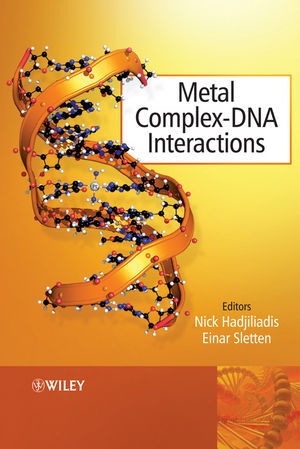Read more
Informationen zum Autor Nikolaos Hadjiliadis is Professor in the Dept of Chemistry at the University of Ioannina, Greece. Einar Sletten is Professor in the Dept of Chemistry at the University of Bergen, Norway. Klappentext Metal ions and metal complexes have long been recognized as critically important components of nucleic acid chemistry, both in regulation of gene expression and as promising therapeutic agents. Understanding how metal complexes interact with DNA has become an active research area at the interface between chemistry, molecular biology and medicine.Metal Complex - DNA Interactions provides a comprehensive overview of this increasingly diverse field, presenting recent developments and the latest research with particular emphasis on metal-based drugs and metal ion toxicity. The text is divided into four parts:* Basic Structural and Kinetic Aspects: includes chapters on sequence-selective metal binding to DNA and thermodynamic models.* Medical Applications: focuses on anticancer platinum drugs, including discussions on DNA repair in antitumor effects of platinum drugs and photo-dynamic therapy.* DNA-Recognition - Nucleases and Sensor: describes probes for DNA recognition, artificial restriction agents, metallo-DNAzymes for metal sensing applications and metal ion dependent catalysis in nucleic acid enzymes.* Toxicological Aspects: deals with structural studies of mercury-DNA interactions, chromium-induced DNA damage and repair, and the effect of arsenic and nickel on DNA integrity.This book will be a valuable resource for academic researchers and professionals from a range of pharmaceutical and chemical industries, particularly those involved in the development of new and less toxic anticancer metallo-drugs, and in the field of environmental and toxicological chemistry. Zusammenfassung Metal ions and metal complexes have long been recognized as critically important components of nucleic acid chemistry, both in regulation of gene expression and as promising therapeutic agents. Understanding how metal complexes interact with DNA has become an active research area at the interface between chemistry, molecular biology and medicine. Inhaltsverzeichnis A Basic Structural and Kinetic Aspects 1. Sequence-Selective Binding of Transition Metal Complexes to DNA 2. Thermodynamic Models of Metal Ion -DNA.Interactions 3. Metal Ion Coordination in G-quadruplexes 4. Supramolecular Chemistry of Metal-Nucleobase Complexes B Medical Applications 5. Platinum Drugs, Nucleotides, and DNA: the Role of Interligand Interactions, nucleotides and DNA 6. Role of DNA Repair in Antitumor Effects of Platinum Drugs 7. Telomeres and Telomerase: Potential Targets for Platinum Complexes 8. Toward Photodynamic Therapy of Cancer with Platinum Group Metal Polyazine Complexes 9. Platinated Oligonucleotides: Synthesis and Applications for the Control of Gene Expression 10. New Titanium and Ruthenium Anticancer Drugs and their Interaction with DNA C DNA-Recognition - Nucleases and Sensors 11. Groove-Binding Ruthenium(II) Complexes as Probes of DNA Recognition 12. DNA Recognition and Binding by Peptide-Metal Complex conjugate 13. Artificial Restriction Agents - Hydrolytic Agents for DNA Cleavage 14. New Metallo-DNAzymes: Fundamental Studies of Metal-DNA Interactions and Metal Sensing Applications 15. Two-metal Ion Dependent Catalysis in Nucleic Acid Enzymes D Toxicological aspects 16. Mercury- DNA Interactions. Structural Studies on MercuryII -Mediated T-T Base-Pair with NMR Spectroscopy 17. Chromium-Induced DNA Damage and Repair 18. Arsenic and nickel: Mechanisms Affecting DNA Integrity ...

